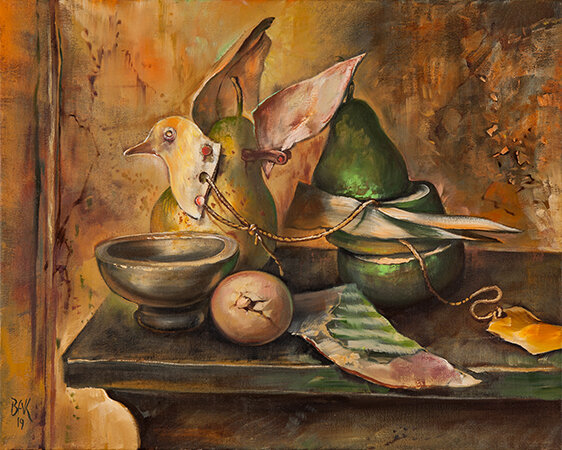New Voices in the Conversation: Samuel Bak Essay Interpretations
With our re-imagining of events as online “Webinarts,” we hosted "New Voices in the Conversation: An Interpretive Essay Contest” to coincide with Samuel Bak’s exhibition Ongoing Conversation: Birds in the Art of Samuel Bak. Prior to the event, participants wrote their own interpretive texts about Sam Bak’s work from his latest series on birds. The five winning essays were presented during the live virtual event in which Sam Bak, Professor Gary Phillips, Gallery Owner Bernie Pucker, and Catalogue Author Jeanne Koles thoughtfully discussed the interpretive essays and how they captured the essence of Sam Bak’s artwork.
All essay submissions, including the 5 winning essays by Ann Hannum, Nadine Payn, David Boocker, Erica Brown, and Laura Mandel, are presented here to showcase the wide breadth of interpretations that were submitted. We hope that these essays will enrich your experience of Sam’s artwork and serve as a catalyst for a continued discussion about its importance and impact.
Still Life of a Green Bird, 2015
Oil on linen, signed "BAK 15" lower left
36 x 36"
BK2379
Ann Hannum
“This isn’t your usual still life—still only in certain respects. Despite an overall sense of stillness, paralysis—not to be confused with serenity—just beneath the surface is great movement. History seethes, the reverberations of unspeakable human acts persist, and human forces of heartbreak, understanding, and redemption struggle. Either fury or the persistence of faith could be responsible for the implied movement of wings attached to a variety of objects, aflutter, as if hope and desperation are vying for dominance—or, as if life is still present.”
Nadine Payn
“Bak’s questions and painterly skills mesmerize me. I cannot avert my gaze. Can you?”
To the Left, 2013
Oil on linen, signed "BAK" lower left
12 x 16.25"
BK2387
A Nest of One’s Own, 2019
Oil on linen, signed "BAK 19" lower right
20 x 16"
BK2371
David Boocker
“In the center of the painting rests the nest, or tree house. A tree house is not simply a place to which children can escape; tree houses have been employed by humans as places to escape from danger, as practical instruments from keeping families safe and as ways of living above inhospitable ground. An effective tree house is built in deciduous trees, as is Bak’s, but in order to survive, it has to be built in a healthy tree with a solid, intact root structure. Bak’s tree house is built atop a rootless tree, part of which is not even connected to the ground. …The black bird in the upper right corner is landing cautiously on a dead branch, as if recognizing that this is not a safe nest.”
Erica Brown
“The combination of fruit and wings hearkens to an ancient garden filled with fruit and doves: the love nest in the Song of Songs. Flora and fauna mirror and amplify the love. Doves appear in almost every chapter. ‘Behold, you are fair, my darling, behold, you are fair, with your dove-like eyes! And you, are beautiful, my beloved, handsome indeed!‘ (Song of Songs 1:15-16).”
Still Still, 2019
Oil on linen, signed "BAK 19" lower left
16 x 20"
BK2367
On Going Conversation, 2019
Oil on linen
20 x 16"
BK2370
Laura Mandel
“Beyond the surreal intrigue of the painting, I realized that I was drawn into this painting because it tells my story…”
Christine Arveil
“I was not there, but the splinter pierces my bone marrow, and I stare, immobile,
with burnt umber dust scorching my eyes.”
To the East and West, 2019
Oil on linen, signed "BAK 19" lower right
36 x 48"
BK2376
Encounter, 2019
Oil on linen, signed "BAK 19"
16 x 20"
BK2372
Cecilia Witteveen & Siegfried Schäfer
“Were these birds at any time able to fly?”
Rachel Kraft
“When Alice tries to join their merrymaking at the table, the March Hare and the (Mad) Hatter famously tell her there is ‘No room! No room!’ The single chair with the raven standing guard could be shooing away potential ‘Alices.’
How many times have wanderers heard those words?”
On Going Conversation, 2019
Oil on linen
20 x 16"
BK2370







